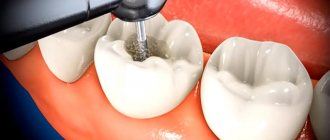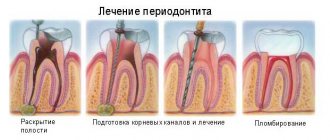Flux is one of the most unpleasant phenomena in dental practice. It is a growth with purulent contents located on the gum. The tumor is formed due to inflammation of the periosteum. As a rule, it occurs against the background of advanced dental diseases.
Did flux form after installing the filling? Are your gums swollen and painful? In this case, you should contact your doctor or another dentist as soon as possible. Do not delay your visit to a specialist to prevent the development of more serious complications.
Causes of dental periostitis
In dentistry, gumboil is commonly called periostitis of the jaw. According to statistics, this disease is diagnosed in approximately 5% of patients. In most cases, the infectious-inflammatory process affects the lower jaw and occurs in an acute form.
Periostitis can be provoked by:
- chronic periodontitis - prolonged inflammation of the periodontal tissues,
- alveolitis - infection of the socket after tooth extraction,
- jaw cyst is a benign neoplasm with liquid contents,
- complicated wisdom tooth eruption,
- mechanical damage to the jaw,
- sore throat, flu, acute respiratory viral infections,
- dentist mistakes when cleaning tooth canals and filling.
After installing a filling, flux may form due to hidden inflammation. When a toothache occurs, many patients take painkillers rather than see a doctor. Tablets eliminate pain, but not its cause.
Cure a tooth, exacerbation of periodontitis, swelling of the cheeks, gumboil, cure inexpensively
TREATMENT OF PERIODONTITIS
Price from 4000 rubles, anesthesia is included in the price.
Page Topics
- Signs of exacerbation of periodontitis (flux)
- Dental anesthesia is included in the price
- Treatment of periodontitis - canal therapy
- Filling tooth canals with gutta-percha and sealer
- Tooth filling (filling or inlay)
- The price of periodontitis treatment is 4000 rubles
- 24/7 inexpensive
- inexpensive dentistry 24 hours
- It hurts to bite on a tooth
“Currently, the vast majority of clinicians attribute chronic periodontitis to infectious foci.” With this phrase, allow me to quote Professor Evgeniy Vlasovich Borovsky, who made a huge contribution to world and Russian dentistry. Samara dentists agree with their teacher on everything. Elimination of infectious foci in the oral cavity is the main task of Samara dentists.
It is difficult for the patient to determine the cause of the disease. He cannot correctly formulate a diagnosis, which is natural. It so happened historically and linguistically that in Russian most exacerbations of diseases in the oral cavity are called gumboil or swelling of the cheek . Well, okay, what’s wrong with this, if a person called “Exacerbation of chronic periodontitis” with the short and clear word flux, everything is clear to everyone, until the fifties this name was officially used in textbooks on dentistry and in scientific works. Now we are more inclined to Latin transcription
Flux treatment of periodontitis is affordable
What are the signs of periodontitis in the acute stage?
Usually the cheek swells in the morning. Waking up, a person notices that the eye is swollen or a double chin has appeared, in general, the face is distorted. The skin is stretched and the entire half of the face hurts excruciatingly. This is for you and me, dear dentists, everything is clear and the diagnosis just begs to be spoken - periodontitis has worsened. But such a situation frightens a normal person and he turns to the browser, describing his situation. A frequent search query on the topic of dentistry is “cause of swelling” or inexpensive dentistry to treat a tooth.
We will try to explain what happened. Most likely, a long-treated tooth due to some circumstances became a source of infection. The pathogenic microflora, which had previously been dormant in the tooth, suddenly began to multiply and burst out of the canals into the surrounding tissues. They reacted to this with swelling. If you have previously used medications for toothache for a long time, they have reduced your immunity. Hypothermia or a cold provoked everything, usually people themselves notice that the tooth has caught a cold. It was painful to bite on the tooth for a long time, or there was bad breath. When a doctor conducts an examination, in most cases the diagnosis is exacerbation of chronic periodontitis. It is for this case that insurance has been invented all over the world, since treatment of periodontitis is not cheap and is always at the wrong time. Here is a rough description of the stages of treatment.
Anesthesia is always used to treat periodontitis.
The absolute principle is complete anesthesia. It may take a little longer than usual. It is difficult for the anesthetic to penetrate the nerve trunks, the cheek is swollen, the gums and teeth have become isolated by a shaft of edema. Nevertheless, dental anesthesia always has an effect, since today dentists use painkillers based on articaine, most often made in French, German or Spanish. In different countries, payment for dental anesthesia is carried out differently. Somewhere this is a separate item in the price list and dentistry declares itself to be inexpensive, indicating the price only for the treatment of periodontitis, but forgetting to indicate the cost of tax and the price of anesthesia. In our office, the price of anesthesia for the treatment of periodontitis is included in the cost of treatment, no matter how many capsules are used.
Cleaning the tooth canals from microbes is a treatment in itself.
Next, the dentist needs to influence the flora in the tooth canal, remove inflammation in the periodontium, and stimulate periodontal regeneration. To remove swelling, anti-inflammatory drugs and antibacterial drugs are prescribed
To begin with, you need to find the canals of the tooth. Here, the dentist faces many technical challenges; the anatomy of multi-rooted teeth is very variable. Depending on age, the canals may begin at different depths, they may be obliterated, or they may split.
The canals of the tooth can be significantly curved. Modern instruments penetrate into any dental canal, regardless of the radius of curvature. But it is obvious that a curved canal takes longer to process. Sometimes the treatment process requires several visits; this, of course, affects the final cost of dental treatment; periodontitis is rarely treated inexpensively.
In many cases, it is incorrectly treated teeth with remnants of old filling material that give the diagnosis of chronic periodontitis. The reasons for failure are listed in this article; let's assume that the dentist treated the tooth, but the microorganisms turned out to be stronger. It is possible to make another attempt to treat the tooth, expand the canals, process it and again fill it with high quality. In some cases this is worth doing. Sometimes, if a tooth is significantly damaged, it makes sense to replace it with an implant, especially if the total cost of treatment becomes comparable to implant surgery, but the prognosis for treatment is still questionable. Residual infection in the periapical tissues will be present in a suppressed form. The flora does not immediately give up, but goes into “dormant” mode, microbes form L-forms that wait for better times - weakening of the immune system, acute illness, age-related changes
Difficulties in the treatment of dental periodontitis
One of the reasons for the development of chronic periodontitis is errors in X-ray diagnostics. Not always an x-ray can give the doctor an objective picture of the size of the tooth, the location of the canals, and the quality of filling these canals. The doctor may be convinced of the quality of his work, the photograph confirms his belief, but after a tooth is removed, many years later the doctor discovers a granuloma
Sometimes toothache that develops as a result of exacerbation of chronic periodontitis is extreme. This happens especially often at night. When severe swelling occurs within a couple of hours, a person immediately tries to find 24-hour inexpensive dentistry. The periosteum becomes inflamed and peels off. In this case, analgesics hardly help; they simply cannot penetrate the area of inflammation. Antibiotics are also ineffective. Usually, only tooth extraction and an incision can help a person; in this case, the accumulated exudate or pus through the hole and the incision comes out, relieving the condition. Swelling after treatment subsides gradually over 3-4 days.
In developed countries, root canal treatment is a very expensive procedure; diseased teeth are usually removed for economic reasons. This explains the fact that, with such highly developed dentistry in Europe and America, many acquire removable dentures already in middle age. In Russia, due to the presence of remnants of the domestic scientific school, the cost of root canal treatment is more affordable.
A modern dentist, in addition to traditional endodontic instruments, also has more advanced devices. These are endodontic handpiece systems with computerized force control on the instrument. These devices quite accurately imitate the movement of the doctor’s fingers in the mouth, but at the same time they are miniature, do not allow the instrument to break in the canal of the diseased tooth (especially with the correct setup of the device and new instruments), and most importantly, they are equipped with an apex locator.
Nevertheless, for high-quality treatment of a diseased tooth, it is necessary to use hand instruments. We performed test fillings on phantoms to monitor different techniques, materials, and recommended protocols. They took extracted teeth, fixed them in transparent silicone, and gradually filled the canals under magnification. It’s an amazingly exciting activity, you constantly learn a lot of new things, train both your fingers and your head. The trajectory of the instruments in the canal, the degree of condensation of gutta-percha, and the interaction of the sealer and filler with the apex of the tooth are clearly visible.
We can responsibly promise that the diseased tooth will be treated efficiently and will last for many more years, decades. The cost of treating periodontitis in a single-canal tooth is about 3,500 rubles. Additional visits are paid separately - 500 rubles (with anesthesia). At least two additional visits are required to change the medicinal compositions in the canals.
It can be argued that all single-channel teeth, and these are incisors, canines and 5 teeth, are guaranteed to be cured in all stages of periodontitis. They have an easily accessible, wide channel that is easy to treat. If this cannot be done conservatively, through a canal, surgical methods with resection of the cyst give very good results. The anterior group of teeth is important both functionally and aesthetically. After treatment, the front teeth will last for decades and the cost of treating a tooth with periodontitis is much less than the cost of an implant. So, it is more profitable to pay dearly for high-quality treatment of periodontitis in a regular clinic than to then look for inexpensive implants in inexpensive dentistry and shudder at the quoted prices.
At the same time, the treatment of multi-canal periodontitis teeth, due to anatomical atypia and the complexity of access to the canals, should proceed from common sense. Sometimes it is worth recognizing the irrationality of further therapy and considering implantation options.
Filling a tooth canal prevents the proliferation of microorganisms in the canal in the future.
A filling filler (gutta-percha pins or heated gutta-percha) and a sealer - various types of pastes - are inserted into the canal, the task is not to leave room for microbes to multiply. Typically, the central channel is connected to many narrow channels that are inaccessible to instruments. Teeth cuts showed that even dense sealing of the canals, carried out with all pedantry, leaves bubble inclusions. But solutions have been found that solve these problems and teeth are treated without complications.
Clinical picture
A clear sign of gumboil is a lump on the gum with purulent contents. Before its formation, the disease makes itself felt by throbbing pain in the tooth. Symptoms of the pathology are also:
- swelling and redness of the gums,
- swelling of the cheek or lip,
- enlarged lymph nodes,
- pain when opening the mouth and swallowing,
- discomfort when pressing on a tooth,
- increase in body temperature,
- excessive weakness
- decreased appetite.
If you detect at least one of the listed signs of flux, you should contact the dentist. You should not warm the sore spot with a warm compress, take antibiotics without a doctor’s prescription, or open an abscess at home.
Why does alveolitis occur after wisdom tooth removal?
Edema, as a consequence of alveolitis, can occur for various reasons, namely through the fault of the doctor or the patient himself.
Causes of edema when the doctor is to blame:
- A cyst remained under the extracted tooth.
- The doctor incorrectly applied stitches, which came apart and exposed the alveolar bone.
- The doctor did not prescribe an antibiotic to the patient after the removal of a wisdom tooth due to a purulent process.
- The doctor left a foreign body in the hole - pieces of a tooth, bone, instrument, etc.
- Causes of edema, when the patient is to blame:
- The patient did not comply with recommendations for oral hygiene in the postoperative period.
- The patient rinsed his mouth vigorously, which led to the flushing out of the blood clot covering the wound.
- The patient chewed hard food on the side of the extracted tooth, which led to suture dehiscence and exposure of the alveolar bone.
- The patient did not take antibiotics prescribed by the doctor after a complex wisdom tooth extraction.
Whatever the cause of pathological swelling, it is necessary to get rid of it under the supervision of experienced specialists. Call ICDI ROOTT toll-free at 8 800 775–26–37 and make an appointment with a doctor at any of the clinics – on Dmitrovskaya and Proletarskaya. We will provide high-quality treatment - therapeutic, physiotherapeutic or surgical - to stop the processes that cause swelling of the soft tissues of the face.
Diagnosis and treatment
To make a diagnosis, the doctor only needs to examine the oral cavity and study an X-ray of the jaw. The flux treatment regimen is compiled individually for each patient. This may include:
- complex treatment of caries, pulpitis or periodontitis,
- taking antibacterial drugs,
- opening the abscess and draining the contents,
- rinsing the mouth with antiseptic solutions,
- physiotherapy - UHF, laser therapy, electrophoresis.











